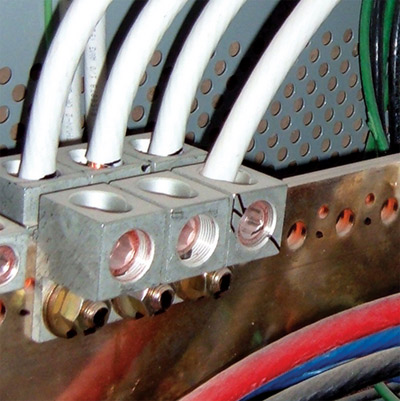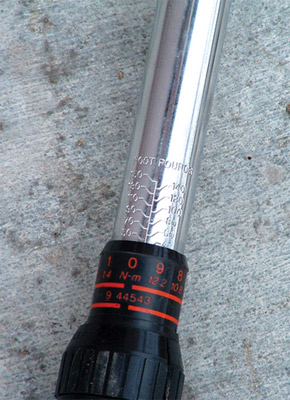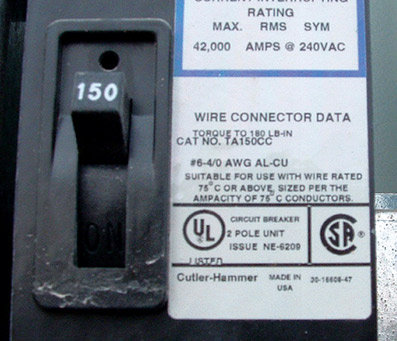Good workmanship requires that the professional electrician make sure that equipment is suitable for the installation and used in ways that comply with applicable codes and job requirements. Since most electrical equipment must be physically connected by some form of conductor, those connections are critical to the long-term reliability and safety of the installed electrical system. Developing good connection techniques and understanding what makes a good connection are the hallmarks of a professional electrician.

Photo 1. Listing Mark
Every connection is critical, because every connection has the potential to fail and create an outage or start a fire. Connections are the most likely point of failure in an electrical system, but it may take years after the initial poor connection is made for the connection to fail. Rarely is the reason for failure attributed to the initial installation, even though it has been demonstrated repeatedly that improper torque will eventually lead to failure of an electrical connection.
If you look at the world of electrical equipment, you’ll find inspections and quality control at every step: the conductors, connectors and equipment are all inspected and listed by a third party, typically a nationally recognized listing agency. Electrical manufacturers also have internal quality control procedures to verify that the products and components meet the applicable standards and expectations.

Photo 2. Set-screw connections
Once the equipment gets onto the jobsite, the electrician verifies that he or she has the right components for the job. This includes appropriately sized equipment, compatible connectors and the right type of conductor. Electrical inspectors typically check to verify the equipment and installation meet the National Electrical Code.
So where does this system break down?All along the line we have inspections, quality control, and more inspections. Unfortunately, one of the most critical parts of ensuring a safe and reliable electrical system is often given little thought and less attention: making connections. Particularly with mechanical set-screw connections, most electricians believe that as long as you have it pretty tight, the connection is good. Few electricians take the care to use a torque wrench or torque screwdriver and make sure that those connections are tightened to the manufacturer’s recommended torque values. Inspectors may check to make sure the connectors don’t easily slip out of the connector, but they can’t be there to watch every connection get tightened with a torque wrench or screwdriver.
TheNECgives clear instructions regarding electrical connections. In 110.14(A) Terminals, the Code states, “Connection of conductors to terminal parts shall ensure a thoroughly good connection without damaging the conductors and shall be made by means of pressure connectors (including set-screw type), solder lugs, or splices to flexible leads.” So with set-screw type connectors, how can we ensure a “thoroughly good connection” and do it so that we avoid “damaging the conductors” in the process?

Photo 3. Scale on Torque Wrench
The only reliable way to make a good connection without damaging the conductor in a typical set-screw type connector is to tighten the screw to the recommended torque value. The only way to accurately tighten the screw to the proper value is to use a torque instrument, either a torque wrench or a torque screwdriver, depending on the type of connector. A study1performed in 2009 showed that over half of set-screw connections made without a torque wrench were under-tightened to values less than 80%. Nearly one-third of connections were tightened to values less than 50% of the recommended torque. One-quarter were over-tightened to values higher than 120% of the recommended torque. What do all these numbers mean? They mean that if you do not use a torque tool to tighten set-screw connectors, you only have a 25% chance of getting within 20% of the recommended torque. On the other hand, if you use a torque tool, you can make every connection correctly every time, and thereby comply with the requirements of the NEC.
In the 2011NEC, there is a new Informative Annex I, “Recommended Tightening Torque Tables from UL Standard 486A-B.” UL Standard 486A-B is titled “Wire Connectors” and is used to list connectors for aluminum, copper and copper-clad aluminum conductors. There are two columns (“A” and “B”) in each of the tables in Annex I. When used for listing connectors, Column A values are used for current-cycling tests, and Column B values are used for all other tests. When used for field connections, the values in Column B are the appropriate torque values to use. Although manufacturers can and do specify differing torque values (with appropriate testing) for connections, the standard values in Column B are commonly used. These values correspond to those published by major connector manufacturers such as Burndy, ILSCO and others.

Photo 4. Torque Screwdriver
Annex I states that “In the absence of connector or equipment manufacturer’s recommended torque values, Table I.1, Table I.2, and Table I.3 may be used to correctly tighten screw-type connections for power and lighting circuits.*” The asterisk directs the reader to the statement “For proper termination of conductors, it is very important that field connections be properly tightened. In the absence of manufacturer’s instructions on the equipment, the torque values given in these tables are recommended. Because it is normal for some relaxation to occur in service, checking torque values sometime after installation is not a reliable means of determining the values of torque applied at installation.”

Photo 5. Torque Values on Equipment Label
These statements tell the user two important things. First, only use the Annex I, Column B values if specific torque values are unavailable for some reason (for example, older equipment with missing labels). Second, tightening connections to the recommended value in the field is critical for terminating conductors. Given the requirements in 110.14 and the information provided in Informative Annex I, there is no logical reason for an electrician not to use the proper tools and methods to terminate conductors.











Find Us on Socials